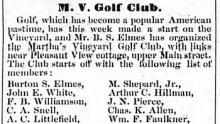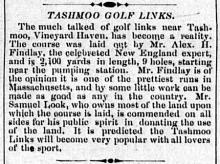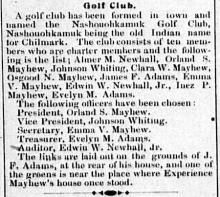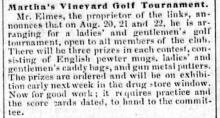They say that the beginnings of the game of golf are lost in history - but it’s not quite that bad on Martha’s Vineyard. Golf, as known to modern man, began here in the early nineties. How the Island had struggled along, no one can say, but it has not been without golf for any appreciable time since, and probably never will again.
Combining history with tradition - and there is fully as much of the former as of the latter in this review - the priority of golf on Martha’s Vineyard seems to line up as follows:
1893 (or thereabouts) - six hole course near the West Chop Light.
1895 (or thereabouts) - Highland golf course, East Chop.
1896 - Martha’s Vineyard Golf Club at Edgartown. It was at what was known as Jernegantown in those days, near the present residence of Leonard Henrickson, then called Pleasant View Cottage.
1897 - Oak Bluffs course, now the course of the Martha’s Vineyard Country Club.
1898 - Tashmoo golf course on the ancient Look farm overlooking Lake Tashmoo near Vineyard Haven.
1899 - Nashonohkamuck Golf Club, Chilmark, course on the former James F. Adams farm.
And on Chappy Too
1900 (or thereabouts) - six hole course on Chappaquiddick.
1905 - Pineside Golf Links at Edgartown, near the site of the present Edgartown Golf Club.
1926 - Edgartown Golf Club.
1939 - Mink Meadows Golf Club at West Chop.
Of this rather imposing list of courses, all of which were sporty in their day and on all of which some notable residents and summer residents of the Island contested with zest and skill, only three remain - the Edgartown Golf Club, Martha’s Vineyard County Club, and Mink Meadows Golf Club.
Here’s a look backward, at the dawning of the 1949 season, with a selection of early golf annals.
The first West Chop Golf Club was organized in 1893 - or thereabouts. History cannot say exactly, unless some scion of a charter member will fill in the gap.
Several West Choppers, it appeared, felt the need of exercise and were enamored of the “new” game of golf. C. C. Jackson became president and C. P. Greenough, W. J. Badger, C. B. Gookin, R. G. Shaw and Dr. Homans were prominent among the membership. Six holes were laid out in the vicinity of the lighthouse, and it is recorded that fog was one of the hazards.
There were others - hazards were of such a special luxuriousness that it was hard to say where hazard ended and fairway began. Greens were in such a rough state that mashies were often used for putting. But the sport was not deterred, and this early venture led to the laying out of the Tashmoo golf course as will be reported presently.
Meantime East Chop had caught the contagion of golf and had launched the Highland Athletic Club, which sponsored field and track events as well. The late Frank A. Ferris, long an East Chop summer resident, supervised the younger players, and each season ended with a banquet. Among the golfers of that period were members of the Meleney family, still loyal to the Island and to the piney fragrance and wide vistas of East Chop.
Built by Volunteer Talent
The nine hole course constructed by volunteer talent, and the “greens” were of sand - but that was the case in some much more elaborate courses of the period, The holes, it is recalled were somewhat short. The Highland club was formally disbanded in 1903, but the course lingered on until the Tennis Club was built in 1910. At that time a decision was reached to abandon golf, as too far-flung and costly to maintain, and to carry on with tennis alone. But of course by then the Country Club course was available.
The first Edgartown course, that of the one and original Martha’s Vineyard Golf Club, was established by B. F. Eimes, a real estate dealer from Springfield. The club was announced in the Vineyard Gazette on July 2, 1896, in these words:
“Burton S. Elmes has organized the Martha’s Vineyard Golf Club with links near the Pleasant View Cottage, upper Main street. A professional, P. Webster, from G. A. Spalding Brothers, New York, laid out the links.” And among the charter members were several townspeople and summer residents still vert much alive and active - including: Arthur B. Hillman, Marshall Shepard, Mrs. Fannie Howard, Miss Mattie Modley, Miss Miriam Beetle, Miss Christine Pease, and Andrew C. Littlefield. The late Gen. Charles K. Allen was one of the summer visiting members.
Of the first season, not much has come down to the present. Of the second season, 1897, the Gazette could report: “Golf at the Martha’s Vineyard Golf links located on upper Main street (Jernegantown) has had a most successful season, and under the courteous management of Mr. Elmes the links are becoming more and more popular.”
By this time the membership included the late Miss Annie F. Mayhew, Stephen O. Edwards, E. P. Chapin, Barton Chapin, Marcus W. Jernegan, Fellows Gaines, and Sol Smith Russell, famous American actor, among many others.
“Best Gents’ Score”
The “best gents’ score” was 49, made by M. J. Hill of Boston; the best ladies’ score was 66, Mrs. C. L. Hill, Boston.
The club went along at a high pitch of popularity. In 1898, year of the Spanish-American War, Mr. Elmes was able to inform the Gazette that the stars and stripes were flying over “Pleasant View, Bay View, and the golf field.”
A tournament in 1901 found competition stimulated by pewter mugs and gun metal putters as prizes. Miss Sara Joy Mayhew won a putter with a score of 94. Some of the leaders in play were Felix Rackemann who made a score of 96 for eighteen holes and, with a handicap of 21, netted 75; Frank Keenan, celebrated actor, who went around in 120 and netted 85; Henry B. Thomas, 102, net 73; and Barton Chapin, 116, net 83.
Arthur B. Hillman, now president of the Edgartown National Bank, can look back across the years at the era of his charter membership in this club. “I made the longest shot ever made on the course,” he remarks with a reminiscent smile. “I was driving from a hill, and it was not only a downhill shot but there was a fair wind. The ball went 311 feet, I believe it was.”
Mr. Hillman recalls that he used a heavy driver that had lead on the bottom - he’s never seen one like it since. There were no pine trees on the golf course of that day; the pines came in later. The greens were of grass, au naturel, and not too fine by modern standards. But no one around Edgartown had played much of any golf before the advent of Mr. Elmes, and the course provided a lot of fun and an introduction to the game under happy circumstances.
The first record of the Oak Bluffs course in the files of the Gazette is simply this, in the issue of Aug. 19, 1897: “The Golf Club are enjoying their new pastime.”
Amateur players had laid out tees and greens on the Benjamin Davis farm, then owned by Frank Chase. The first course was of nine holes, and sand greens and rough fairways were difficulties as on the other early Island links, but nothing interfered with the zest of the players. Among them were Dr. Harry Tucker, son of the famous Dr. Harrison L. Tucker, Horace Richards, Dr. Daniel Dorchester, and many of the Harts of Hart Haven. There was nothing quite like being out on an invigorating day, hitting and following the ball with the blue Sound on one hand and Sengekontacket Pond on the other.
A Caddy House Was Built
A caddy house was built and an Englishman named Ely became the first professional. He was not only an excellent instructor and player, but it is recalled that he was a master hand at the art of club-making. He had been a pupil of the famous Scotch professional, Willie Dunn, and had learned to play with leather balls stuffed with feathers. If these balls were hit too hard, or if they were topped or sliced, the feathers would fly.
After a few years of more or less spontaneous golfing on this new course, Edward Mulliken, a promoter, took it in hand with serious and practical intentions. It was his idea that the Oak Bluffs course could be ready early in May, just to attract the crowd of professionals and enthusiasts who would be finishing up in Florida at that time of year.
Due to the Vineyard’s mild climate play could start here in advance of the regular northern golf season, and players who so desired could keep in practice between the two seasons, southern and northern. Mr. Mulliken might have succeeded, but it happened that he was the owner of one of the first automobiles to be brought to Martha’s Vineyard, a two-cylindered French car. Driving past Tashmoo in the clatter and fumes that went with early motoring, he was unaware that a farmer named Scott had taken a team of horses off the road to avoid meeting the automobile. One of the horses bolted, even although taken into a side road, and the farmer was thrown and killed.
Faced with a charge of manslaughter and also in other difficulties, Mr. Mulliken decided to accept an offer made by Lyman W. Besse for the purchase of the club. The dues had not paid the expenses of increasing the course from nine to eighteen holes, nor had they paid the salaries of the top notch professionals Mr. Mulliken had employed.
One of these professionals had been a man named Finley, well known at the time and under his care the course had been improved until it had a par of 76.
Mr. Besse was a summer resident devoted to the good of his town and of the Island, and he proceeded to direct the destinies of the Oak Bluffs Country Club into constructive channels. The clubhouse was built in 1910.
The Professionals
The professionals brought to the club course included Jim Hendry, and in 1921 he was followed by Bill Cooper. Colin Dow came in 1923, and Fred Chisholm in 1924. The following year the course was in Charge of James Andrews, and after a year he was succeeded by Thomas J. Attridge, who has continued ever since, and under whom the name was changed to Martha’s Vineyard Country Club in token of enlarged scope.
Some of the flavor of early events associated with the club is conveyed by an 1899 item from the Gazette: “A pleasant reception was tendered at the golf grounds on Saturday. The rooms were cozily fitted up with tea table, chocolate table, ice cream and cake table, presided over by Mrs. Richards, the wife of the president, Mrs. Fennessy and others. A large number of invited guests were present and it was one of the social events of the season.”
Next chronologically was the Tashmoo course of 1898. “The much talked of golf links near Tashmoo, Vineyard Haven, has become a reality,” the Gazette reported. “The course was laid out by Mr. Alex H. Findlay, the celebrated New England expert, and is 2,100 yards in length, 9 holes, starting near the pumping station. Mr. Findlay is of the opinion it is one of the prettiest runs in Massachusetts and by some little work can be made as good as any in the country. Mr. Samuel Look, who owns most of the land upon which the course is laid, is commended on all sides for his public spirit in donating the use of his land.”
Among the West Choppers - mostly those who had whetted their golfing taste on the earlier course near the lighthouse - who were pioneers at the Tashmoo course were C. C. Jackson, president; C. P. Greenough, W. J. Badger, C. B. Gookin, R. G. Shaw and Dr. Homans. Most of the names of the golfers had been associated with West Chop for two generations or more.
Charming Country Range
For description we have this: “The golf club at Tashmoo is in no way pretentious, but one has only to visit it to find a more charming country range of fields and woodlands. From one high hill the visitor looks away to another, with smooth, rolling country in between. The lake lies before you, with grass-grown shores and trees, cool trees that rustle and rock and play in the summer wind. Beyond lies all Vineyard Sound.”
The same writer characterized West Chop as a place where people “live a summer life very quietly among themselves, a little colony that has no teas, no dances, no social extravagances of any sort to worry over.” He made it sound so unexciting that his readers could well believe West Chop needed to find a relief in golf.
The first tee was near the state road, and also near the winding road to the pumping station. “There,” this early account put in, although it could hardly be germane, “water of notable purity is obtained.”
“The drive-off is in a westerly direction to the smooth bald head of a hill. As one goes over the crest, the lake appears before him, and he must stop and look; and, close by, at the right, another diversion presents itself. There stand two gravestones, with a smaller one shrinking behind them.
“From one the stroller learns there lie the remains of Seth Daggett, who died of smallpox April 14, 1779, aged 66 years, and engraved over the inscription is the uncanny head of a skull, with wild looking eyes and what appears to be a tight-fitting standing collar about its neck.”
A clear drive of about 200 yards reached the next hole, set on a hillside; and the green, it was noted, offered some difficulties even to experts because of its tilt. In one spot it was necessary to drive over or through a stand of oaks. The holes averaged about 200 yards, the longest being 282.
The membership of the West Chop Golf Club, which used the Tashmoo course, was never large. But the West Choppers who - still quoting contemporary sources 0 desired exercise, were not alone in their game. Enthusiasts simply obtained permission from Samuel Look to knock balls around. Par was a difficult 50 for the 9 holes.
Particularly Terrifying
The greens that were of stubbly grass and the hazards were particularly terrifying in their natural contours. Three regular players were Peter Cromwell, Dr. John C. Rolfe, and Charles H. Brown.
“One of the hardest ordeals the triumvirate had to face,” wrote a journalist at a later date, “was an old bull belonging to Farmer Look. For several seasons the bull had been as peaceful and benevolent of appearance as a purring pussy, but a radical change in his diet affected his nature. Through a long winter Farmer Look had fed turnips to his bull for his daily meals.
“Now, with Peter Cromwell nourishing high hopes of breaking the 50 par with a particularly hefty drive, Senor Bull decided that the approaching ball was a little free turnip tea. Grasping the ball firmly in his gargantuan jaws, the bull ambled away from the green with Charlie Brown giving wild chase. When the bull was finally persuaded to drop the ball, Peter Cromwell’s lie was not only bad but he was a good number of yards being his starting point.
“A heated altercation arose. ‘Was this a natural hazard of the course?’ Both Brown and Rolfe agreed that it was, and the bull and all his kind went down several pegs in Cromwell’s estimation.
The Tashmoo club was formally dissolved in 1946 and the links became a thing of the past. One difficulty in the later phase had been a drive across the state highway, which was banned by law.
Most of those who know Martha’s Vineyard may be surprised to learn that Chilmark also was early in the golfing parade - although more properly, the Nashonohkamuk Golf Club belonged to West Tisbury. It just happened that the course was over the town line in Chilmark, fo it was laid out in the rear of the James F. Adams farm, and one of the greens was near the spot where once had stood the homestead of Rev. Experience Mayehw, one of the unforgettable missionaries to the Vineyard Indians.
The first president of the club was Dr. Orland S. Mayhew, and Johnson Whiting of West Tisbury was vice president, with Emma V. Mayhew - later Mrs. Whiting - as secretary. Mrs. Evelyn M. Adams was treasurer, and Edwin W. Newhall Jr. was auditor.
It is not on record how long this club endured, but it had a day and no doubt a good one, for the terrain was excellent and the group who formed the club was a rare company of congenial friends.
Years later there was golf in Chilmark, and it was well publicized. but the game would not be recognized by any record-keepers. The late Clare Briggs, famous cartoonist depicted the sport in some of his drawings that were syndicated nationally. Sheep were traveling bunkers, and the Atlantic was the water hazard. The courses existed only as long as a congenial company, including Mr. Briggs, Percy Cowen, and it was said, sometimes Capt. George Fred Tilton, chose to play - then it became sheep pasture again.
Of the six hole course on Chappaquiddick, not much exact information remains. It was laid out in amateur but not amateurish fashion on land owned by Dr. Frank L. Marshall, a pioneer summer resident of the island. The Marshalls, the Seegers and other Chappaquiddick tribes - and this word is used advisedly, since all Chappaquiddickers tend to form tribes and have their own customs and even their own war cries - played the six hole course for years. The greens were small and were made of clay and sand, and one important feature of the course was an elevated, basin-like green, par of which was one stroke.
Next in order came the Pineside links of the Edgartown Golf & tennis Club, which succeeded in a general way to the pioneer course of Mr. Elmes. Pineside, however, was on the other side of the road from the original courses, on pasture land of C. F. Shurtleff, part of it comprised in the modern Edgartown Golf course. As the name implies, the terrain was beautified by pines.
Quite the Correct Thing
“The Edgartown Golf & Tennis Club was organized this week,” the Gazette announced on June 22, 1905, “and starts off with a good list of members. Good grounds are to be secured and it is going to be quite the correct thing to become a member and play golf this summer.” J. R. Hammer was president and John E. White was treasurer.
In July the Pineside links were opened. The course was 2.540 yards long and was “in the opinion of experts an unusually successful reproduction of golfing conditions on the downs of Scotland where the game originated.” The course had nine holes, and play soon became enthusiastic. Charles F. Shurtleff became treasurer and Rev. Frederick Morse Cutler, then a pastor at Edgartown, became secretary.
There was a rule against Sunday play, but Mr. Cutler told the Gazette many years later that the rule was “self-enforcing” in that gentle era. Mr. Cutler said that bogie was 39. Those who played the course were about equally divided among summer visitors and all-year residents.
But after three seasons, Mr. Hammer, who had been the most active spirit, was unable to continue. The equipment was transferred to Mr. Shurtleff, and the course was kept in existence for some time longer.
One record still preserved shows that the fees at Pineside were $4 for men and $2 for ladies. Children under 16, instead of being barred, were admitted for $1.50. A family ticket for the whole season could be had for $12, with guest privileges. This schedule of fees is enough to fill modern golfers with envy, as, indeed, is much of the history of the old Island courses where the sport flourished in true sporty fashion.
In Modern Times
In 1926 Cornelius S. Lee, long a lover of the Vineyard and for four years previously secretary of the U. S. Golf Association, planned the Edgartown Golf Club, and among those who joined him as founders were William B. Dinsmore, Elmer J. Bliss, Marshall Kernochan, Robert Potts, John Inman, Bancroft Davis and other loyal summer residents. About 150 acres were utilized and the course proceeded to make history - it is now so well known that documentation is hardly needed.
Last, chronologically, of the modern golf courses is that at Mink Meadows, projected as far back as 1928 by Robert L. Bigelow, but not opened for play until 1939. Planned and developed with exceeding care, the course took rank with the favorites of skilled golfers, and so it stands today. The course is on an L-shaped tract some two miles in length.











Comments